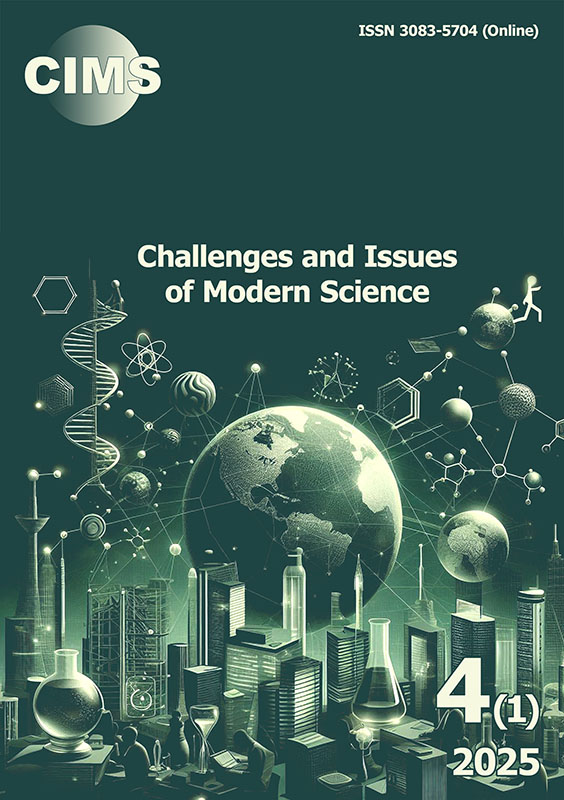Modeling fin efficiency considering transverse temperature gradients in rocket engine cooling channels
DOI:
https://doi.org/10.15421/cims.4.299Keywords:
mathematical model of heat transfer, transverse temperature non-uniformity, liquid propellant rocket engine, cooling channels of the engine chamberAbstract
Purpose. This study aims to improve the accuracy of methods for determining fin efficiency. Its goal is to derive calculation relationships for finning coefficients that account for transverse temperature non-uniformity within the fin cross-section. Design / Method / Approach. The article presents the reduction of the heat conduction equation for a fin to a dimensionless form, based on dimensional analysis of the variables involved. Further development relies on analyzing the results of numerical simulations and their subsequent generalization. To this end, the gradient descent method is applied, minimizing the quadratic error function. Findings. A criterial dependence has been formulated to complement the derived heat conduction equation. Test calculations and comparisons with numerical simulations in Ansys Fluent confirm an improvement in calculation accuracy when using the proposed equation. Theoretical Implications. This paper addresses factors previously neglected in the analysis of heat transfer in fins. The results of the study thus complement existing approaches to determining finning coefficients. Practical Implications. The derived criterial relationship will enhance the accuracy of heat transfer calculations in the chambers and gas generators of liquid rocket engines. Originality / Value. The paper introduces an original criterial relationship that accounts for temperature non-uniformity across the fin cross-section. Incorporating this factor improves calculation accuracy, highlighting the practical value of the developed equation. Research Limitations / Future Research. This study focuses on rectangular fins; therefore, the proposed model is not applicable to fins with variable thickness in the ducts of liquid propellant rocket engines (LPREs). Developing a fin model without these limitations will be the objective of future research on this topic. Article Type. Applied Research.
Downloads
References
Atefi, E., & Naraghi, M. H. (2019). Optimization of regeneratively cooled rocket engines cooling channel dimensions. In AIAA Propulsion and Energy 2019 Forum (p. 3938). https://doi.org/10.2514/6.2019-3938
Bilohurov, S., Myshenko, O., & Bardakov, S. (2024). Experimental Study of Throttling of Solid Fuel Direct-Flow Steam Boilers [In Ukrainian]. Challenges and Issues of Modern Science, 2, 72-77. https://cims.fti.dp.ua/j/article/view/129
Bucharskyi, V., Zhang, L.-H., & Wan, Y.-L. (2018). Improvement in Time Efficiency in Numerical Simulation for Solid Propellant Rocket Motors (SPRM). Journal of Propulsion Technology, 39 (1), 92-99. http://dx.doi.org/10.13675/j.cnki.tjjs.2018.01.010
Fagherazzi, M., Santi, M., Barato, F., & Pizzarelli, M. (2023). A Simplified Thermal Analysis Model for Regeneratively Cooled Rocket Engine Thrust Chambers and Its Calibration with Experimental Data. Aerospace, 10(5), 403. https://doi.org/10.3390/aerospace10050403
Forsberg, C. H. (2021). Steady-state conduction. In Heat Transfer Principles and Applications (pp. 57–120). Academic Press. https://doi.org/10.1016/b978-0-12-802296-2.00003-2
Jeong, W., Jang, S., & Kim, H.-J. (2023). Characteristics of a Heat Exchanger in a Liquid Rocket Engine Using Conjugate Heat Transfer Coupling with Open-Source Tools. Aerospace, 10(12), 983. https://doi.org/10.3390/aerospace10120983
Kim, S.-K., Joh, M., Choi, H. S., & Park, T. S. (2014). Effective Modeling of Conjugate Heat Transfer and Hydraulics for the Regenerative Cooling Design of Kerosene Rocket Engines. Numerical Heat Transfer, Part A: Applications, 66(8), 863–883. https://doi.org/10.1080/10407782.2014.892396
Kose, Y. M., & Celik, M. (2023). Regenerative Cooling Comparison of LOX/LCH4 and LOX/LC3H8 Rocket Engines Using the One-Dimensional Regenerative Cooling Modelling Tool ODREC. Applied Sciences, 14(1), 71. https://doi.org/10.3390/app14010071
Leonardi, M., Pizzarelli, M., & Nasuti, F. (2019). Analysis of thermal stratification impact on the design of cooling channels for liquid rocket engines. International Journal of Heat and Mass Transfer, 135, 811–821. https://doi.org/10.1016/j.ijheatmasstransfer.2019.02.028
Lv, J., Du, G., Jin, P., & Li, R. (2023). Heat Transfer Analysis and Structural Optimization for Spiral Channel Regenerative Cooling Thrust Chamber. International Journal of Aerospace Engineering, 2023, 1–17. https://doi.org/10.1155/2023/8628107
Mitikov, Y., & Sedchenko, M. (2023). Critical analysis of helium gas bottle inflation systems for rocket engine fuel tanks [In Ukrainian]. Challenges and Issues of Modern Science, 1, 117-125. https://cims.fti.dp.ua/j/article/view/23
Mohr, D. L., Wilson, W. J., & Freund, R. J. (2022). Linear Regression. In Statistical Methods (pp. 301–349). Academic Press. https://doi.org/10.1016/b978-0-12-823043-5.00007-2
PTC Inc. (2025). Mathcad: Math Software for Engineering Calculations. PTC Inc. https://mathcad.com
Sichler, E., Montes, J. D., & Chandler, F. O. (2018). One dimensional thermal steady state analysis and procedure for a low-pressure liquid oxygen and liquid methane rocket engine. In 2018 Joint Propulsion Conference (p. 4602). https://doi.org/10.2514/6.2018-4602
Sliusariev, V., & Bucharskyi, V. (2024). Development of a mathematical model for the cooling channel of a liquid propellant rocket engine’s chamber with respect for variations in coolant density. Eastern-European Journal of Enterprise Technologies, 6 (1 (132)), 14–20. https://doi.org/10.15587/1729-4061.2024.316236
Sliusariev, V., & Bucharskyi, V. (2024). Mathematical model for heat transfer in variable thickness fins for rocket engines. Challenges and Issues of Modern Science, 3, 48–54. https://cims.fti.dp.ua/j/article/view/234
Sukachevskyi, V., & Shevtsov, V. (2024). Application of computer-integrated technologies in rocket engine design [In Ukrainian]. Challenges and Issues of Modern Science, 3, 62–73. https://cims.fti.dp.ua/j/article/view/201
Ting, D. (2022). Dimensional analysis. In Thermofluids (pp. 181–198). Academic Press. https://doi.org/10.1016/b978-0-323-90626-5.00003-3
Tokarskyi, I., & Habrinets, V. (2024). Design Analysis and Calculation Methods for Furnace Oil Burners in Heating Systems [In Ukrainian]. Challenges and Issues of Modern Science, 3, 55–61. https://cims.fti.dp.ua/j/article/view/225
Vekilov S. S., Lipovskyi V. I., Marchan R. A., & Bondarenko O. E. (2021). Distinctive features of SLM technology application for manufacturing of LPRE components. Journal of Rocket-Space Technology, 29(4), 112-123. https://doi.org/10.15421/452112
Virtanen, P., Gommers, R., Oliphant, T. E., Haberland, M., Reddy, T., Cournapeau, D., Burovski, E., Peterson, P., Weckesser, W., Bright, J., van der Walt, S. J., Brett, M., Wilson, J., Millman, K. J., Mayorov, N., Nelson, A. R. J., Jones, E., Kern, R., Larson, E., … Vázquez-Baeza, Y. (2020). SciPy 1.0: fundamental algorithms for scientific computing in Python. Nature Methods, 17(3), 261–272. https://doi.org/10.1038/s41592-019-0686-2
Williams, M. (2023). SpaceX sets new record with successful test-firing of 31 Raptor engines. Universe Today. https://www.universetoday.com/articles/spacex-sets-new-record-with-successful-test-firing-of-31-raptor-engines
Wolfram Research, Inc. (2025). Mathematica 12.3. Wolfram Research, Inc. https://www.wolfram.com/mathematica
Xu, B., Chen, B., Peng, J., Zhou, W., & Xu, X. (2023). A Coupled Heat Transfer Calculation Strategy for Composite Cooling Liquid Rocket Engine. Aerospace, 10(5), 473. https://doi.org/10.3390/aerospace10050473
Downloads
Published
Versions
- 2025-06-24 (2)
- 2025-06-23 (1)
Issue
Section
Categories
License
Copyright (c) 2025 Volodymyr Sliusariev, Valerii Bucharskyi (Author)

This work is licensed under a Creative Commons Attribution 4.0 International License.
All articles published in the journal Challenges and Issues of Modern Science are licensed under the Creative Commons Attribution 4.0 International (CC BY) license. This means that you are free to:
- Share, copy, and redistribute the article in any medium or format
- Adapt, remix, transform, and build upon the article
as long as you provide appropriate credit to the original work, include the authors' names, article title, journal name, and indicate that the work is licensed under CC BY. Any use of the material should not imply endorsement by the authors or the journal.



















